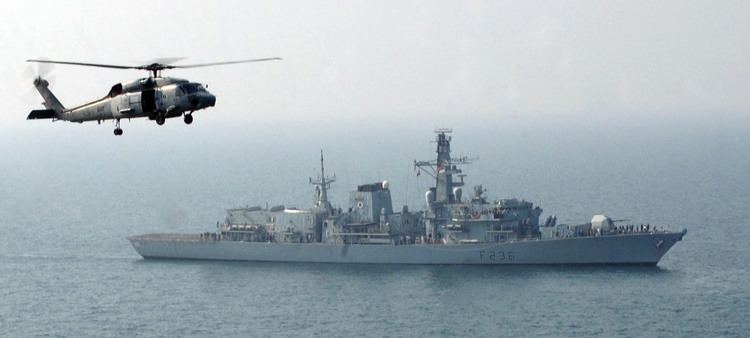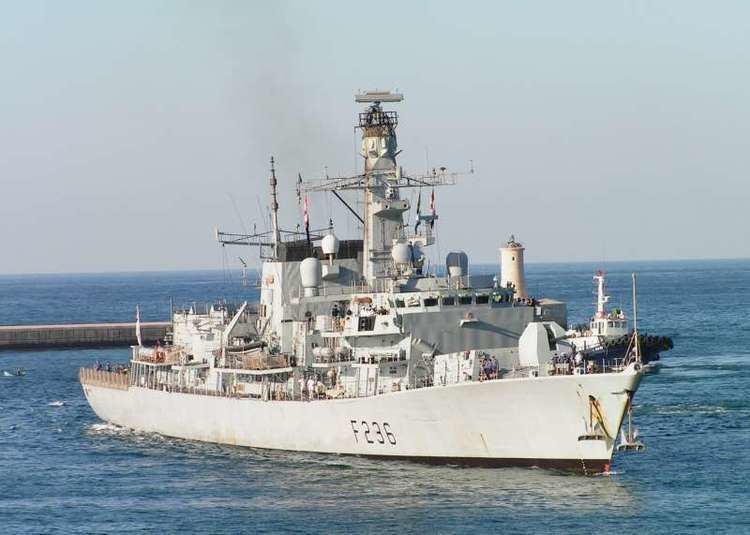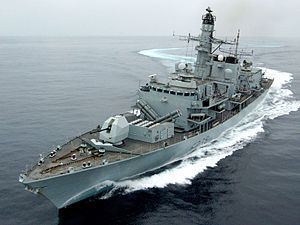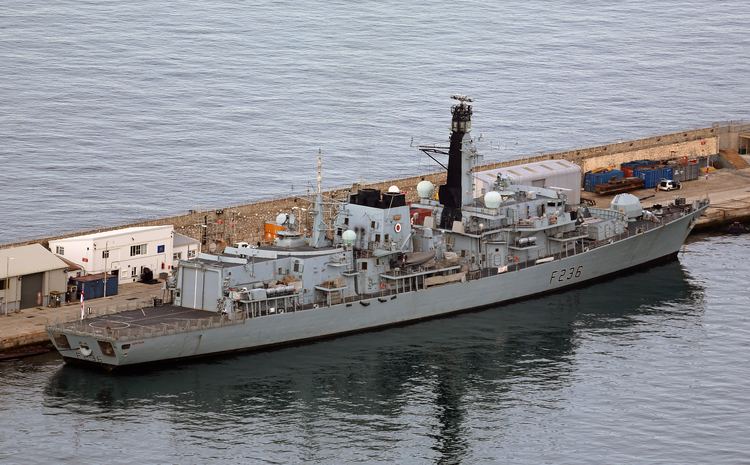Laid down 1 November 1989 Commissioned 2 June 1994 Construction started 1 November 1989 Length 133 m Draft 7.3 m | Ordered July 1988 Sponsored by Lady Rifkind Refit Major 2014-2016 Launched 31 July 1992 Weight 4,900 tons | |
 | ||
Royal navy type 23 frigate hms montrose f236 fires harpoon anti ship missiles
The current HMS Montrose is the eighth of the sixteen ship Type 23 or Duke class of frigates, of the Royal Navy, named after the Duke of Montrose. She was laid down in November 1989 by Yarrow Shipbuilders on the Clyde, and was launched on 31 July 1992 by Lady Rifkind (when, as Mrs Edith Rifkind, her husband Sir Malcolm Rifkind was Secretary of State for Defence). She commissioned into service in June 1994.
Contents
- Royal navy type 23 frigate hms montrose f236 fires harpoon anti ship missiles
- Royal navy type 23 frigate hms montrose f236 fires harpoon antiship missiles
- 1994 2000
- 2001 2010
- 2011 Present
- Visits to Dundee and Montrose
- Commanding officers
- Prizes and awards
- Battle honours
- Affiliations
- References

Having once been the flagship of the 6th Frigate Squadron, Montrose is now part of the Devonport Flotilla, based in Devonport Dockyard in Plymouth.

Royal navy type 23 frigate hms montrose f236 fires harpoon antiship missiles
1994-2000

Deployments in the 1990s include her first trip to the South Atlantic, as Falkland Islands guardship, which ended in October 1996. Her first visit to the City of Dundee was in 1993. Several NATO deployments followed.
2001-2010

In early 2002, Montrose returned to the Falklands on the now-renamed Atlantic Patrol Task (South) deployment, during which divers from Montrose replaced the White Ensign on Antelope, which was sunk during the Falklands War. On her return from this deployment, she conducted her first refit period (RP1), which was completed in early January 2004.

In October 2004, Montrose was one of a number of ships that was dispatched to the rescue of the stricken Canadian submarine Chicoutimi (an ex-Royal Navy Upholder-class submarine) which had suffered a number of fires on board, causing casualties and the loss of power in the submarine. Montrose was the first Royal Navy vessel to make contact with the boat and assisted the submarine.

Montrose deployed in 2006 to the Persian Gulf on Operation Telic in the first half of 2006. After returning to the UK for personnel changes and maintenance, from 8 January to 27 July 2007, Montrose then deployed for seven months to the Mediterranean Sea as the UK contribution to the Standing NATO Maritime Group Two (SNMG2). As part of this group, she participated in NATO’s Operation Active Endeavour (OAE), countering terrorist activity in the Mediterranean and preventing smuggling and other illegal activity. After Summer Leave, the ship headed to Scotland to take part in Exercise Neptune Warrior, during which time she was visited by Prince Michael of Kent, Honorary Rear Admiral of the Royal Naval Reserve, on 24 September 2007.
Following Operational Sea Training, Montrose deployed again to the Middle East on 12 March 2008 to join Combined Task Force (CTF) 150, operating in the Gulf of Aden and the Arabian Sea. Activity in this deployment included Exercise KhunjarHaad, a multi-national exercise held in the Gulf of Oman, and (working with Chatham, Edinburgh and RFA Argus the seizure of over 23 tonnes of drugs including cocaine, hashish, amphetamines and opiates. She returned home on 3 October 2008, and after operating in UK waters, commenced a £15,000,000 upkeep package at Rosyth in early 2009.
This second refit package (RP2) included a number of major capability upgrades for the ship, including the first fitting of the Royal Navy’s newest command system, DNA(2), and the replacement of the two old manually-operated 30 mm guns with two 30 mm DS30M Mark 2 Guns. Having rejoined the ship on 20 July 2009, the crew conducted post-refits trials until January 2010, and Montrose was formally accepted back into the fleet on 11 February 2010.
After operational sea training Montrose deployed to Arabian Sea in Summer 2010 to conduct anti-piracy operations, highlights of which included the November 2010 destruction of a Somalian pirate ship by the ships Lynx helicopter while on patrol off the coast of Somalia and the disruption of several pirate attacks on merchant ships.
2011-Present
In October 2011, Montrose deployed again to the South Atlantic, during which she was due to visit Callao, Peru in March 2012, but the Peruvian government cancelled the visit, according to the Foreign Minister, as a gesture of solidarity with Argentina over the Falklands. After visits to New Orleans and Bermuda in March and April 2012, Montrose returned to the UK in May 2012. In July 2012, the ship acted as the escort vessel for Queen Elizabeth II during her Diamond Jubilee visit to Cowes.
From September to November 2012, the ship participated in the COUGAR 12 deployment to the Mediterranean. In early 2013, the ship and crew underwent intensive training to return to the front line, and then deployed as part of the COUGAR 13 task group in August 2013. After the remainder of the COUGAR 13 task group returned to the UK, Montrose remained in the Middle East to act as the UK's frigate in the Persian Gulf under Operation KIPION, and conducted numerous exercises with allied nations, as well as UK-only training events such as the maintenance exercise with RFA Diligence.
In 2014, Montrose was tasked to join Norwegian and Danish warships in Operation RECSYR - the mission to escort the merchant vessels removing the Syrian chemical weapons stockpile for destruction. Having handed over to HMS Diamond, the ship arrived home in March 2014. Subsequently, and after a high profile London visit to celebrate 20 years since the ship's commissioning, the ship was sent to the Baltic Sea to participate in BALTOPS 14, a large scale US-led multinational exercise with participation from 30 ships and submarines from 14 nations.
The ship entered refit at Devonport in October 2014, and was due to rejoin the Fleet in 2016 however the decision was made to slow the refit to allow the installation of the Sea Ceptor Missle system and a new Command System.
Visits to Dundee and Montrose
Montrose has visited the city of Dundee on many occasions, include Easter 1997, 6–9 November 1998 (Dundee Navy Days), 9 October 2004 (for wreath-laying ceremony commemorating the 200th anniversary of the death of Admiral Adam Duncan), 4 June 2005, and 9–13 November 2006 (covering the Remembrance Sunday memorial service).
The port of Montrose is smaller than Dundee, but Montrose has been able to call in four times in her history. The first visit took place in November 1999, and has only happened three times subsequently, once in July 2002, when the ship was granted the Freedom of Angus by the Provost Mrs Frances Duncan, and marched through the town, and six years later in November 2008, when the-then Angus Provost Ruth Melville took the salute during a Remembrance Sunday parade in which this Freedom was exercised. The ship returned to Montrose in July 2014, where they exercised the Freedom of Angus in front of Provost Helen Oswald, as well as conducting numerous engagements in the local area.
Commanding officers
As the flagship of the 6th Frigate Squadron (or F6), many of the first commanding officers of HMS Montrose were Captains, rather than Commanders, as they had administrative responsibility over all the Type 23 frigates based in Devonport. The equivalent squadron for the Portsmouth-based Type 23s was the 4th Frigate Squadron. With the abolition of the frigate and destroyer squadrons in 2002/3, and their replacement by flotillas, command of Montrose reverted to a that of a Commander.
Of this list, three Commanding Officers have been subsequently promoted to Vice Admiral, including the husband of the Princess Royal, Timothy Laurence, who assumed command of the ship (and the 6th Frigate Squadron) on 27 August 1996.
(decorations and ranks detailed at the time of being in Command, and do not reflect subsequent promotions, or honours and awards)
Ten of the former Commanding Officers were reunited on board Montrose on 30 May 2014 at a lunch held to celebrate the 20th anniversary of the ship's commissioning, when they were invited on board while the ship was in London; the ship's sponsor, Lady Rifkind, also attended.
Prizes and awards
At the end of 2014, HMS Montrose was awarded the Fleet Effectiveness Trophy for best frigate in the Royal Navy in 2014.
Battle honours
There has only been one previous ship built with the same name, which was Montrose (D01), the first of eight Admiralty-type destroyer leaders, sometimes known as the Scott class. However, whichever tender was attached to the Tay Division of the Royal Naval Reserve was always renamed HMS Montrose in honour of James Graham, 6th Duke of Montrose, who founded the Royal Naval Volunteer Reserve in 1903; the last ship that was so named was the Ton-class minesweeper HMS Stubbington.
All of HMS Montrose battle honours were won by her WWII-era predecessor, and are as follows:
The honours board for that ship can be seen on board the preserved frigate HMS Unicorn, alongside in Dundee.
